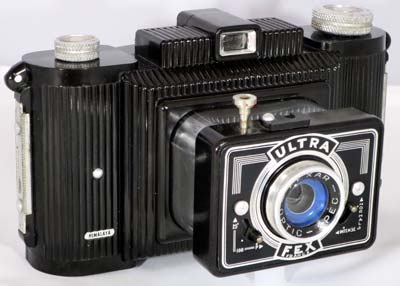Fex/Indo Ultra Himalaya
Specification

| Manufacturer | : | Fex/Indo |
|---|---|---|
| Produced | : | 1951 |
| Classification | : | Medium Format |
| Body Type | : | Extending Box |
| Construction | : | Bakelite |
| Film Type | : | 620 |
| Film Width | : | 62mm |
| ImageSize | : | 2¼ x 3¼ in |
| No. of Images | : | 8 |
| Lens Type | : | Meniscus |
| Focus Type | : | Fixed |
| Focal Length | : | 90mm |
| Focal Range | : | 3m - inf. |
| Aperture Type | : | Multihole |
| Aperture | : | f/16; f/22 |
| Shutter Type | : | Rotary |
| Shutter Speeds | : | B, I(1/25s,1/100s) |
| Size Open (w x h x d) | : | 155 x 87 x 93 mm |
| Size Closed (w x h x d) | : | 155 x 87 x 75 mm |
| Weight | : | 355g |
Art Deco Credentials
![]()
![]()
![]()
![]()
Significant: Pronounced and self evident
- Produced after the main Art Deco period.
- Moulded Bakelite body.
- Multi-line deep pattern in Bakelite.
- Design shows stepped features.
- Curvilinear shape
- Square chrome extension tube.
- Multi-line geometric pattern in chrome on face plate.
- Concentric circles on red window shutter.
Description
The camera is part of a range of cameras having similar design with regard to the Bakelite body. The heavily ribbed nature was first seen in the Fex/Indo Superior camera which came out in 1940. The ribbed design continued until 1957.
This is a 6x9 format camera, 8 images per film, using 620 film. The advance knob of the film is aluminum. There is a second aluminium knob to the right of the box which is secured to a threaded rod which serves as an axis to the supply reel. The objective lens is labelled 'FEXAR - OPTIC - SPEC' and is a meniscus lens. It is surrounded by a bluish aluminum collar which stands out beautifully. It has 2 openings on a sliding aperture plate labelled "Normal" and "Intense". These were measured as f/16 and f/22.
The shutter has 3 positions: 100, 25 and P (P = pose, corresponding to Bulb). The shutter release with a metal head is located on the lens plate. The lens plate must be fully deployed until an arrow is seen on the metal extension tube. The shutter has a lock which moves into place when the lens is retracted.
There is no adjustment of the focus with the objective lens set on the hyperfocal distance to give a clear image between 2 or 3 meters and infinity. There is a thread for a tripod. The "Himalaya" logo is on the bottom right of the camera. Apparently, Fex sponsored a Himalayan expedition in 1951, and began marketing a few Ultra Fex models as such.
How to Use
This camera takes 620 film which is still available from selected photographic outlets. Although the actual film is the same as 120 film, the spools are different. The 620 spools are slightly shorter and have a smaller diameter. Do not use 120 film in this camera because it will jam and may snap. It is possible to re-spooling 120 on to 620 spools in a darkroom or changing bag.
Another issue is that the 620 spool must be an old metal type that has a hole right through to take the feed side spindle. Modern plastic spools will not work. So buying 620 is probably not an option you will need to re-spool it yourself. Make sure you use the old type metal spindles.
This camera has two aperture settings labelled 'normal' (f/16) and 'intense' (f/22). The available speeds are 1/25s and 1/100s. Don't forget to fully deploy the metal extension tube.
If you don't want to bother with an exposure meter, follow the guide shown. It is based on the 'Sunny 16' rule. Film is so forgiving and will produce acceptable results even when overexposed by 2 or 3 stops or underexposed by 1 stop.
Remember that the exposure guide in the camera user manual may not be helpful as it is based on the use of old film with a low ISO value.
The tables assume that the sun is at least 30 degrees above the horizon - that's 10am - 5pm on a summer's day in the UK.
If you are not sure about the light level, err on the side of overexposure - i.e. assume the smaller f number.
Where there is a choice, a larger f number will give a larger depth of field.
For the slower speeds, you may need a tripod to stop blur through shake.
Using ISO 100/125
Key: Green - Good exposure; Amber - acceptable exposure; Red - unacceptable exposure. Number of stops over or under shown.
| Weather Conditions | Shadow Detail | Shutter Speed (s) | |
|---|---|---|---|
| 1/25 | 1/100 | ||
 Sunny SunnySnow/Sand | Dark with sharp edges | f/22 +2 over | f/22 |
 Sunny Sunny | Distinct | f/22 +1 over | f/16 |
 Slight Overcast Slight Overcast | Soft around edges | f/22 | f/16 -1 under |
 Overcast Overcast | Barely visible | f/16 | f/16 -2 under |
 Heavy Overcast Heavy Overcast | None | f/16 -1 under | f/16 -3 under |
 Open Shade Open Shade/Sunset | None | f/16 -2 under | f/16 -4 under |
Being fairly old, it would probably benefit from cleaning the lenses and viewfinders. This is easy to do and most worthwile. Check out my page:- 'Restoration of a Fex/Indo Ultra'.